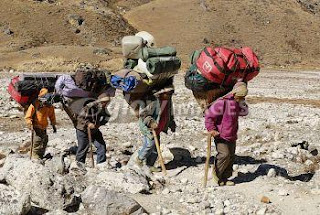 |
| Kearsarge Pass: Still smiling with 37 lbs. |
The following gear checklist is for the average recreational hiker spending 5-7 days between trail heads or food resupply points in the Sierras. Unlike other locations, unique aspects of the Sierras can dictate a heavier pack weight. Bear canisters weight 2.5 lbs and are required in all areas within the three National Parks, and nearly all Wilderness areas of the USFS. Also, the routine trail altitude of 10,500' typically demands warmer shelter, sleeping, and outerwear gear choices. Finally, the need to carry your entire food cache due to limited resupply locations also adds to a hiker's final pack weight.
JMT Gear Checklist updated 15 Aug
Good luck with this checklist. Each gear item is in black. I have added notes of emphasis in red for most items. Notes in blue are my own personal choices and brand favorites. These may not fit your style or they may add a new way of looking at things. The final choice is up to you.
*************************** Food For Thought ***************************
This gear checklist is for multi-day, walk-each-day hiking in the Sierras. Labels like "Thru, Section, or Circuit" hiking is not important here. It is however, NOT "Base-Camping" which is different in that you hike in on one day, stay put for 3+ days and then hike out. In that scenario, hauling 50+ lbs is often the norm... been there done that.
For daily hiking with my male, 180-ish lbs friends, I would strongly advocate a max final wet-pack weight of 35 lbs or less. Less is better! Anything over 40lbs can have a detrimental effect on the hiker's ability to maintain an 8 -12 mile daily mileage schedule over the course of several days. This advice is general in nature. Each hiker's age, size, fitness and endurance levels are different. By comparison, ultra-light Thru-hikers will have a pack weight of less than 20lbs and a daily mileage schedule of 16-20 miles. But as renowned ultra light guru Ray Jardine says, "unless you are willing to embrace the entire ultra light method, do not buy an ultralight pack..." I would encourage you to visit the ultra light sites. They offer exciting alternatives to the off-the-shelf world of REI.
What you can do, is to be honest with yourself on the gear choices you make (want vs need) (comfort vs utility). Share gear items within your group. Minimize packaging and size choices. Try to dual purpose items. Layer your clothes and avoid bulky jackets and pants. Avoid cotton and choose dri-fit performance fabrics.
 |
| Kirby, Mike, John, and Dave |
Finally, the final pack weight you end up with must be a weight you can handle for several days. In a group environment, an overloaded hiker can be a detriment to group harmony and safety.

No comments:
Post a Comment